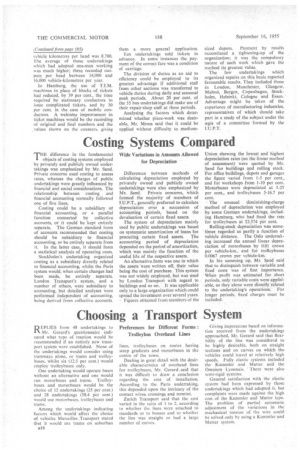Costing Systems Compared
Page 52

If you've noticed an error in this article please click here to report it so we can fix it.
Wide Variations in Amounts Allowed for Depreciation THE difference in the fundamental objects of costing systems employed by privately and publicly owned undertakings was emphasized by Mr. Sand. Private concerns used costing to assess rates, whereas the charges of public undertakings were greatly influenced by financial and social considerations. The relationship between costing and financial accounting normally followed one of five lines,
Costing could be a subsidiary of financial accounting, or a parallel function connected by collective accounts, or it could be kept entirely separate The German standard form of accounts recommended that costing should be subsidiary to financial accounting, or be entirely separate from it. In the latter case, it should form a statistical analysis of operating costs.
Stockholm's undertaking organized costing as a subsidiary directly related to financial accounting, whilst the Paris system would, when certain changes had been made, be entirely separate. London Transport's system, and a number of others, were subsidiary to accounting, but detailed analyses were performed independent of accounting, being derived from collective accounts. Differences between methods of calculating depreciation employed by privately owned and publicly owned undertakings were also emphasized by Mr. Sand. Private concerns, which formed the majority of members of I.U.P.T., generally preferred to calculate depreciation over a succession of accounting periods, based on the devaluation of certain fixed assets.
The system of depreciation mainly used by public undertakings was based on systematic amortization of loans for procuring certain fixed assets. The accounting period of depreciation depended on the period of amortization, which was mainly the function of the useful life of the respective assets.
An altemative.form was one in which the assets 'were written off, their value being the cost of purchase. This system was not widely employed, but was used by London Transport with regard to buildings and so on. It was applicable only to a large organization which could spread the investment over several years.
Figures obtained from members of the Union showing the lowest and highest depreciation rates (on the linear method of assessment) were quoted by Mr. Sand for buildings and rolling stock. For office buildings, depots and garages the figure varied from 1-5 per cent., and for workshops from 1-10 per cent. Motorbuses were depreciated at 5-25 per cent., and trolleybuses 5-16.7 per cent.
The unusual diminishing-charge method of depreciation was employed by some German undertakings, including Hamburg, who had fixed the rate for trolleybuses at 22.574 per cent.
Rolling-stock depreciation was sometimes regarded as partly a function of vehicle distance. The Oslo undertaking increased the annual linear depreciation of motorbuses by 0.01 crown per vehicle-km., and for trolleybuses 0.0067 crown per vehicle-km.
In his summing up, Mr. Sand said that to distinguish between variable and fixed costs was of first importance. When profit was estimated for short periods, only variable costs were applieable, as they alone were directly related to the undertaking's operations. For longer periods, fixed charges must be included. .




































































































